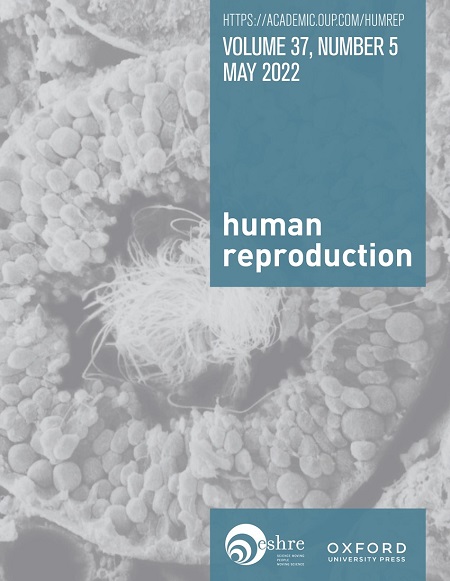复发性流产患者抗核抗体与妊娠预后的关系
IF 6
1区 医学
Q1 OBSTETRICS & GYNECOLOGY
引用次数: 0
摘要
研究问题:在没有抗磷脂抗体(aPL)的情况下,抗核抗体(ANA)是否会影响不明原因复发性妊娠丢失(RPL)患者的后续活产率(LBR) ?结论:不明原因RPL的妇女在妊娠试验阳性后活产的概率很高(70%),与ANA试验阳性和阴性的妇女相似,无论临界值如何。ESHRE的RPL指南指出,“出于解释目的,可以考虑进行ANA测试”。然而,关于这一问题的研究数量有限,样本量较小,ANA对妊娠预后的影响尚不清楚。研究设计、规模、持续时间2006年至2019年在名古屋城市大学医院进行了一项回顾性队列研究。该研究包括1021名原因不明的RPL患者。参与者/材料、环境、方法在随后的妊娠前进行子宫输卵管造影或3d超声,对伴侣双方进行染色体分析,对aPL、ANA、甲状腺功能减退和糖尿病进行血液检查。在Hep-2细胞载玻片上采用间接免疫荧光法测定ANAs。使用的截止稀释倍数为1:40。此外,根据免疫荧光染色的ANA模式对患者进行分类:均匀型、斑点型、核仁型、着丝粒型、外周型、细胞质型等。在排除抗磷脂抗体综合征、配偶一方染色体异常和子宫异常的患者后,比较ana阳性和ana阴性患者的lbr。考虑到截断值= 1:40稀释,ana阳性组随后的lbr为72.5% (256/353),ana阴性组为73.2% (489/668);优势比(OR) = 0.97, 95% CI = 0.72-1.29。在排除胚胎非整倍体流产、生化妊娠丢失和异位妊娠后,ana阳性组的lbr为92.8% (256/276),ana阴性组的lbr为93.0% (489/526),OR = 0.97 (95% CI = 0.55 ~ 1.70)。考虑截止值= 1:80稀释,ana阳性组随后的lbr为75.0% (87/116),ana阴性组为72.7% (658/905);Or = 1.13 (95% ci = 0.72-1.76)。在排除胚胎非整倍体流产、生化妊娠丢失和异位妊娠后,ana阳性组的lbr为89.7% (87/97),ana阴性组的lbr为93.3% (658/705):OR = 0.62 (95% CI = 0.30-1.27)。考虑截止值= 1:160稀释,ana阳性组随后的lbr为82.4% (28/34),ana阴性组为72.6% (717/987);Or = 1.76 (95% ci = 0.72-4.29)。在排除胚胎非整倍体流产、生化妊娠丢失、异位妊娠后,ana阳性组的LBR为93.3% (28/30),ana阴性组的LBR为92.9% (717/772),OR = 1.07 (95% CI = 0.25 ~ 4.63)。调整年龄和BMI前后,两组患者的LBR无差异,但使用1:40稀释时,ana阳性患者明显大于ana阴性患者,使用1:80稀释时,ana阳性患者的BMI明显低于ana阴性患者。由于没有建立健康对照组,因此无法比较健康对照组和RPL患者之间的ANA阳性率。ana阳性组和ana阴性组在年龄(1:40稀释)和BMI(1:160稀释)上有显著差异。研究结果的更广泛意义我们的研究结果表明,ANA检测对于预测未知原因的RPL妇女未来的妊娠损失是无用的。研究经费/竞争利益(S)本研究由文部省特色联合研究中心推广计划支持,批准号JPMXP0621467963,用于英语校对费用。对于所有的作者来说,没有相互竞争的利益。试验注册号n / a。本文章由计算机程序翻译,如有差异,请以英文原文为准。
Association between antinuclear antibodies and pregnancy prognosis in recurrent pregnancy loss patients
STUDY QUESTION Can antinuclear antibodies (ANA) affect the subsequent live birth rate (LBR) in patients with unexplained recurrent pregnancy loss (RPL) in the absence of antiphospholipid antibodies (aPL)? SUMMARY ANSWER Women with unexplained RPL have a high probability of live birth following a positive pregnancy test (>70%), being similar between those with positive and negative ANA testing, regardless of the cut-off value. WHAT IS KNOWN ALREADY The RPL guidelines of the ESHRE state that ‘ANA testing can be considered for explanatory purposes’. However, there have been a limited number of studies on this issue and sample sizes have been small, and the impact of ANA on the pregnancy prognosis is unclear. STUDY DESIGN, SIZE, DURATION A retrospective cohort study was conducted at Nagoya City University Hospital between 2006 and 2019. The study included 1021 women with RPL without known cause. PARTICIPANTS/MATERIALS, SETTING, METHODS Hysterosalpingography or 3D-ultrasound, chromosome analysis for both partners, blood tests for aPL, ANA, hypothyroidism, and diabetes mellitus were performed before a subsequent pregnancy. ANAs were measured by indirect immunofluorescence on Hep-2 cell slides. The cutoff dilution used was 1:40. In addition, patients were classified according to the ANA pattern on immunofluorescence staining: homogeneous, speckled, nucleolar, centromeric, peripheral, cytoplasmic, and others. LBRs were compared between ANA-positive and ANA-negative patients after excluding patients with antiphospholipid antibody syndrome, an abnormal chromosome in either partner and a uterine anomaly. MAIN RESULTS AND THE ROLE OF CHANCE Considering the cut-off value = 1:40 dilution, the subsequent LBRs were 72.5% (256/353) for the ANA-positive group and 73.2% (489/668) for the ANA-negative group; odds ratio (OR) = 0.97, 95% CI = 0.72–1.29. After excluding the miscarriages occurring from embryonic aneuploidy, the biochemical pregnancy losses, and the ectopic pregnancies, LBRs were 92.8% (256/276) for the ANA-positive group and 93.0% (489/526) for the ANA-negative group: OR = 0.97 (95% CI = 0.55–1.70). Considering the cut-off value = 1:80 dilution, the subsequent LBRs were 75.0% (87/116) for the ANA-positive group and 72.7% (658/905) for the ANA-negative group; OR = 1.13 (95% CI = 0.72–1.76). After excluding the miscarriages occurring from embryonic aneuploidy, the biochemical pregnancy losses, and the ectopic pregnancies, LBRs were 89.7% (87/97) for the ANA-positive group and 93.3% (658/705) for the ANA-negative group: OR = 0.62 (95% CI = 0.30–1.27). Considering the cut-off value = 1:160 dilution, the subsequent LBRs were 82.4% (28/34) for the ANA-positive group and 72.6% (717/987) for the ANA-negative group; OR = 1.76 (95% CI = 0.72–4.29). After excluding the miscarriages occurring from embryonic aneuploidy, the biochemical pregnancy losses, and the ectopic pregnancies, LBR were 93.3% (28/30) for the ANA-positive group and 92.9% (717/772) for the ANA-negative group: OR = 1.07 (95% CI = 0.25–4.63). There was no difference in LBR between the 2 groups before or after adjustment for age and BMI, but ANA-positive patients were significantly older than ANA-negative patients when using the 1:40 dilution, and ANA-positive patients had significantly lower BMIs than ANA-negative patients when using the 1:80 dilution. LIMITATIONS, REASONS FOR CAUTION A healthy control group was not established, making it impossible to compare ANA positivity rates between healthy controls and RPL patients. There were significant differences in age (1:40 dilution) and BMI (1:160 dilution) between the ANA-positive and ANA-negative groups. WIDER IMPLICATIONS OF THE FINDINGS Our results suggest that ANA testing is not useful to predict future pregnancy loss in women with RPL without known cause. STUDY FUNDING/COMPETING INTEREST(S) This study was supported by MEXT Promotion of Distinctive Joint Research Center Program, Grant Number JPMXP0621467963 and used for English proofreading costs. There are no competing interests for all authors. TRIAL REGISTRATION NUMBER N/A.
求助全文
通过发布文献求助,成功后即可免费获取论文全文。
去求助
来源期刊

Human reproduction
医学-妇产科学
CiteScore
10.90
自引率
6.60%
发文量
1369
审稿时长
1 months
期刊介绍:
Human Reproduction features full-length, peer-reviewed papers reporting original research, concise clinical case reports, as well as opinions and debates on topical issues.
Papers published cover the clinical science and medical aspects of reproductive physiology, pathology and endocrinology; including andrology, gonad function, gametogenesis, fertilization, embryo development, implantation, early pregnancy, genetics, genetic diagnosis, oncology, infectious disease, surgery, contraception, infertility treatment, psychology, ethics and social issues.
 求助内容:
求助内容: 应助结果提醒方式:
应助结果提醒方式:


